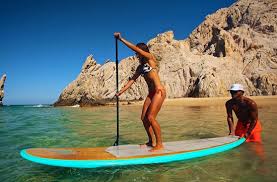10 Tips for Stand Up Paddle Boarding
Top 10 Stand Up Paddle (SUP) Tips
Whether it's your first time on a SUP board or your tenth, take a look at our top 10 tips for beginners and novice boarders. These tips may make a world of a difference in your boarding experience.
- Keep the leash on: This goes for all boards from beginners to pro's, the sooner you are aware how vital a leash is in any kind of condition the safer you and everyone else will be when you are paddling. Choose the right leash for you, there are several types of leashes available. Ask the rental company or your local board shop for the best leash for your type of boarding.
- Make sure you're using your paddle the right way: There is nothing worse than paddling with the wrong side of the paddle. It will make a huge difference for first timers who may not know which side is front and which side is back. When your paddle is faced the right direction it makes for a much smoother and more efficient ride. We always suggest an adjustable height paddle so that you can adjust it to the best length for your height.
- Face the right way: This may seem obvious, however a lot of beginner boards have a large rounded front and tail so it may be a little difficult. So before you jump on the board, check where the fins are and make sure they are in the back when you paddle! Fins at the back help keep the board straight while you paddle, this is called tracking, and help with grip while you surf waves. Fins up front make for a very twitchy paddle board that just won’t go straight no matter how hard you try!
- Use your Core: Your core is one of the strongest muscles in your body. Most beginner boarders try to paddle with their arms, while this will get you where you're going it is not the most effective way. Paddle with your core and you will have a much more enjoyable and efficient ride. On top of that it makes for an awesome ab workout.
- Keep your eyes on the horizon: When most people start out there is a natural tendency to look down at the board. If you keep your eyes up at the horizon it will help you keep your balance and direction of the board. It sounds funny but with your head down watching your toes, you are likely to lose your balance rock back on your heals and splash in the water.
- Mind your space: The ocean is huge, lakes are big and the rivers are wide. Yet we always seem to want to paddle on the same square inch of water! Paddle boards are big and they can hurt when they hit you. Be mindful of other water users and when you’re learning the art of SUP. Make sure you have plenty of room to practice standing, falling and paddling.
- Practice your falls: I know this sounds strange, but even the pros fall off so this is always going to be a part of boarding. What is important though, is how you fall. Just practicing tricks and wave riding, practicing your falls is also important, or at least how you fall to ensure that you fall safely and you do not ruin a day on the water by an injury that could have been easily avoided. Paddle boards are big and can hurt when they hit you, when you fall, you want to fall away from your board. Don’t worry, you’re attached to it with your leash and it won’t go away, but falling well clear of the board will let you fall gracefully into water without falling on the board or the fins. This is especially important in any location with current or waves as the board will move independently of your input.
- Don’t bite off more than you can chew: If you're in the ocean or any body of water with current and waves make sure you can handle the board in those conditions. Even small waves can give you a ride that can be a bit scary. Be smart and catch the right wave for you and your skill level.
- Be mindful of the conditions: This goes for boarders at all skill levels, from wind to wave conditions it's important for you to check the conditions before you head out on the water.
- Keep an eye on your board and paddle: Paddle boards for beginners are big. To make them manageable, maneuverable and strong they need to be built out of lightweight high tech materials making them expensive. Look after your board and paddle, they are fragile when thrown around on land. Your board will thank you!

